One of the most important issues after mitral valve replacement is that patients use blood thinners regularly as recommended by the physician. While the use of blood thinners for biological valve replacement is 3 months, patients must use blood thinners for life in mechanical valve replacement. In addition, it is extremely important to protect the patient from infections. In cases such as surgical interventions that may be due to another disease, it is important for the patient to contact the heart doctor and take preventive measures against infection. However, the patient must undergo regular medical check-ups in which the heart and heart valves are monitored.
Early diagnosis is very important in the treatment of mitral valve diseases. Mitral valve problem detected at an early stage can be treated with mitral valve repair without the need for valve replacement, if the necessary fitness is available.
Koltuk Altı Mitral Kapak Ameliyatının Avantajları
Koltuk altı mitral kapak ameliyatının en önemli avantajı, minimal invaziv bir yöntem olması ve göğüs kemiği kesilmeden yapılabilmesidir. Bu sayede hastalar, ameliyat sonrası daha az ağrı hisseder ve iyileşme süresi açık cerrahiye göre çok daha kısa olur. Koltuk altı girişimi, büyük kesiler ve açık göğüs operasyonları gerektirmediği için enfeksiyon riski de belirgin şekilde azalır. Ayrıca, bu yöntem estetik açıdan da avantajlıdır; ameliyat izleri koltuk altında kaldığı için dışarıdan neredeyse hiç görünmez ve hastanın psikolojik rahatlığına katkı sağlar.
Hastalar, bu yöntemi takiben genellikle daha kısa sürede hastaneden taburcu edilir ve günlük yaşamlarına daha hızlı dönerler. Koltuk altı mitral kapak ameliyatı sırasında cerrah, küçük bir kesiden yüksek hassasiyetle çalışarak, kapak değişimi veya onarımı gerçekleştirir.
Koltuk Altı Mitral Kapak Ameliyatı Kaç Günde İyileşir?
Koltuk altı mitral kapak ameliyatı sonrası hastaların genellikle 2 ila 3 hafta içinde büyük ölçüde iyileşmesi beklenir. Bu süre, ameliyatın minimal invaziv olması ve büyük kesiler yapılmadan gerçekleştirilmesi sayesinde oldukça kısadır. Ameliyat sonrası iyileşme sürecinde hastalar, genellikle ilk birkaç gün hastanede gözlem altında tutulur ve stabil bir şekilde ayağa kalkmaları sağlanır. Taburcu olduktan sonra, hafif fiziksel aktiviteler ve yürüyüşlerle vücut hareket etmeye teşvik edilir, ancak aşırı efor gerektiren aktivitelerden kaçınılması önerilir.
Koltuk altı yöntemiyle gerçekleştirilen bu ameliyat, geleneksel açık kalp cerrahisine kıyasla daha hızlı iyileşme sunar çünkü göğüs kafesi büyük bir travmaya maruz kalmaz. Bu da ameliyat sonrası ağrının az olması, enfeksiyon riskinin daha düşük olması ve günlük yaşama dönüşün hızlanması anlamına gelir.
Hangi Durumlarda Koltuk Altından Küçük Kesi ile Mitral Kapak Ameliyatı Mümkün Olmaz?
Koltuk altından küçük kesi ile mitral kapak ameliyatı, bazı özel durumlarda mümkün olmayabilir. Bu yöntemin uygulanabilmesi için hastanın kalp ve damar yapısının, minimal invaziv cerrahiye uygun olması gerekir. Özellikle ileri düzeyde kalp büyümesi, damar yapısındaki ciddi bozukluklar veya aort damarında genişleme gibi anatomik durumlar, bu tekniği zorlaştırabilir. Ayrıca, mitral kapakta karmaşık onarım gerektiren büyük sorunlar ya da eşlik eden başka kalp hastalıkları bulunuyorsa, geleneksel açık cerrahi daha uygun bir seçenek olabilir.
Önceki kalp ameliyatları nedeniyle göğüs boşluğunda yapışıklıklar oluşmuşsa, küçük kesi ile ameliyat riskli hale gelebilir. Bu durumda, açık cerrahi daha güvenli bir tercih olabilir. Çoklu kapak hastalıkları olan hastalarda, tek bir işlem yerine daha kapsamlı bir müdahale gerekebilir; bu da koltuk altından küçük kesi ile müdahale edilmesini zorlaştırır. Ayrıca, ciddi derecede obezite, minimal invaziv cerrahiyi teknik olarak daha zor hale getirebilir, bu durumda açık cerrahi daha uygun görülür.
Koltuk Altı Mitral Kapak Ameliyatı Yapmanın Hasta Psikolojisi Üzerine Olumlu Etkileri v-Var Mıdır?
Koltuk altı mitral kapak ameliyatı, hastaların psikolojisi üzerinde olumlu etkiler yaratabilir. Minimal invaziv bir yöntemle yapılan bu ameliyat, daha az ağrı, daha kısa iyileşme süresi ve daha küçük kesiler gerektirdiği için hastaların kaygı ve stres düzeyini azaltır. Büyük kesiler yerine koltuk altından yapılan bir kesi ile gerçekleştirilen ameliyat, daha az belirgin bir iz bırakır; bu da hastaların kendilerini estetik olarak daha iyi hissetmelerine yardımcı olur. Ameliyat sonrası iyileşmenin daha hızlı olması, hastaların günlük yaşamlarına ve işlerine daha çabuk dönmelerine olanak tanır; bu durum, sosyal ve duygusal yönden de olumlu etkiler sağlar.
Ağrının az olması ve hareket kabiliyetinin hızla geri kazanılması, hastanın kendine olan güvenini artırır ve ameliyat sonrası süreci daha pozitif geçirmesine katkıda bulunur. Geleneksel açık ameliyatlarla karşılaştırıldığında, koltuk altı yöntemi, hastanın fiziksel travmayı daha hafif geçirmesi nedeniyle psikolojik olarak daha rahat hissetmesini sağlar.
Kapalı Mitral Kapak Ameliyatı Nasıl Yapılır?
Kapalı mitral kapak ameliyatı, minimal invaziv bir cerrahi yöntemle, göğüs kafesi geniş bir şekilde açılmadan gerçekleştirilir. Bu ameliyat sırasında, genellikle kaburgalar arasından veya koltuk altından küçük bir kesi ile kalbe ulaşılır. Ameliyatın temel amacı, mitral kapaktaki sorunları düzeltmek veya kapağı değiştirmektir. Genelde küçük bir alandan çalışarak özel cerrahi aletler ve görüntüleme sistemleri ile hasarlı kapağı onarılır veya gerekirse yeni bir kapak takılır. Bu yöntem, açık ameliyata kıyasla daha az travmatik bir süreç sunar.









